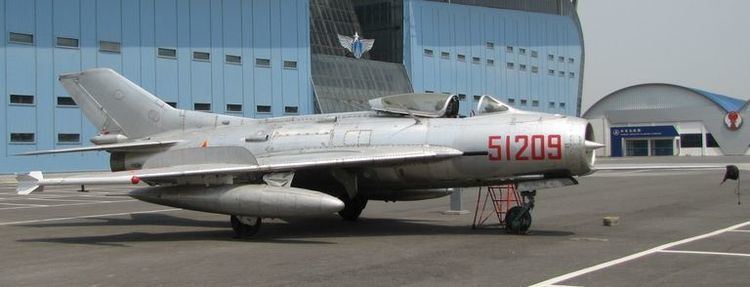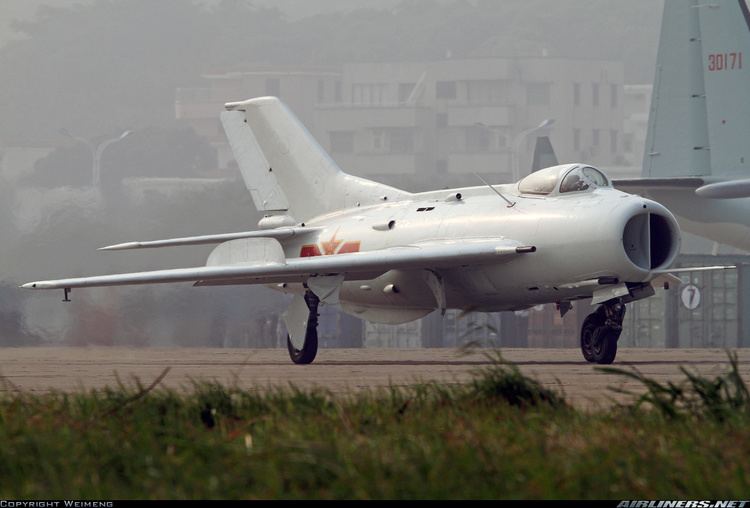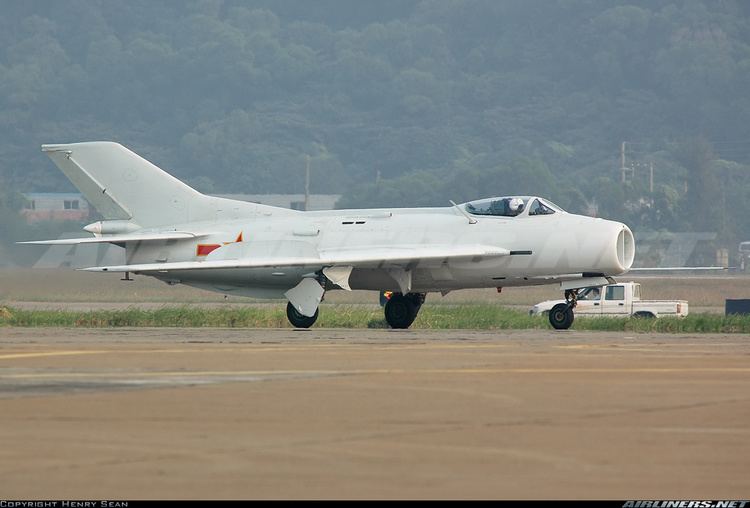Top speed 1,540 km/h Wingspan 9.19 m First flight December 17, 1958 | Length 13 m Engine type Tumansky RD-9 Number of seats 2 | |
 | ||
Manufacturer | ||
Shenyang j 6 chinese fighter aircraft
The Shenyang J-6 (Chinese: 歼-6; designated F-6 for export versions; NATO reporting name: "Farmer") was the Chinese-built version of the Soviet MiG-19 'Farmer' fighter aircraft.
Contents
- Shenyang j 6 chinese fighter aircraft
- Shenyang j 6 fighter aircraft
- Design and development
- Description
- Albania
- Indo Pakistan Wars
- Vietnam War
- Ogaden War
- Uganda Tanzania War
- Kampuchea Vietnam War
- IranIraq War
- Variants
- Operators
- Current operators
- Former operators
- Specifications J 6
- References

Shenyang j 6 fighter aircraft
Design and development

Although the MiG-19 had a comparatively short life in Soviet service, the Chinese came to value its agility, turning performance, and powerful cannon armament, and produced it for their own use between 1958 and 1981. While the basic Soviet-designed MiG-19 has been retired from all nations, the Shenyang J-6 still flies for nine of its original 15 operators, however, in a very limited capacity. The J-6 airframe contributed to the Chinese ground attack version, the Q-5, which still flies for numerous nations.

The J-6 was considered "disposable" and was intended to be operated for only 100 flight hours (or approximately 100 sorties) before being overhauled. The Pakistan Air Force was often able to extend this to 130 hours with diligent maintenance.
Description

The J-6 has a maximum speed at altitude of 1,540 km/h (960 mph), Mach 1.45. Service ceiling is 17,900 m (58,700 ft). Combat radius with two drop tanks is about 640 km (400 mi). Powerplant is two Liming Wopen-6A (Tumansky R-9) turbojet engines. In addition to the internal cannon armament, most have provision for four wing pylons for up to 250 kg (550 lb) each, with a maximum ordnance load of 500 kg (1,100 lb). Typical stores include unguided bombs, 55 mm rocket pods, or PL-2/PL-5 (Chinese versions of Soviet K-13 (NATO AA-2 'Atoll') air-to-air missiles.
Albania

Albanian Air Force J-6s replaced the J-5s on the border to intercept Yugoslav incursions into Albanian airspace. However, the J-6 was ineffective against the faster Yugoslav MiG-21 'Fishbed'. Once the F-7A became available, the J-6 was redeployed to guard Tirana. As of 2005 all Albanian fighters were grounded due to lack of spare parts.
Indo-Pakistan Wars
The F-6 was flown by the Pakistan Air Force from 1965 to 2002, the aircraft design undergoing around 140 modifications to improve its capabilities in the interceptor and close air support roles. The PAF F-6 fighters participated in the Indo-Pak War 1971 against India, scoring approximately 6 confirmed aerial victories including one Indian MiG-21. The three Pakistani J-6 squadrons flew nearly a thousand sorties, during which the PAF lost 3-4 F-6 to ground fire and two to three in aerial combat. An F-6 was also lost to friendly fire. One of the F-6 pilots shot down was Wajid Ali Khan, who was taken as a POW and later became a Member of Parliament in Canada. The single seat F-6 was retired from the Pakistani Air Force in 2002, but the two-seat trainer, the FT-6, remains in service in very small numbers.
Vietnam War
The supersonic speed advantage provided by the MiG-21's more modern turbojet engine was found to be not as useful in combat as originally thought, because aerial dogfights at the time were conducted almost entirely in the sub-sonic speed regime. The J-6 (and hence the MiG-19 also) was found to be more manoeuvrable than the MiG-21 and, although slower, its acceleration during dogfights was considered adequate. The North Vietnamese Air Force fielded at least one unit of J-6 during the war, the 925th Fighter Regiment, beginning in 1969.
Ogaden War
Somalian J-6s participated in the 1977-1978 Ogaden War and suffered greatly because of the superior opposition faced (Cuban pilots fought for Ethiopia). Over 75% of the Somali Air Force was destroyed in the war but some J-6s survived until the country turned into turmoil in the early 1990s.
Uganda-Tanzania War
During the 1978-1979 Uganda-Tanzania War, Tanzanian J-6s and Shenyang F-5s were tasked to handle any possible Ugandan fighters which consisted of MiG-15s and MiG-17s, while F-7As were tasked to handle more advanced aircraft of Ugandan allies, such as the Libyan Tupolev Tu-22 'Blinder'.
Kampuchea-Vietnam War
In the era of Khmer Rouge control of Cambodia (1975-1979), Chinese-supplied Khmer J-6s participated in Kampuchea-Vietnamese border clashes for ground attacks. During the Vietnamese invasion in 1978, the Cambodian aircraft were reluctant to take-off to intercept the Vietnamese ones, thus the Vietnamese captured a number of J-6s and put them on public display.
Iran–Iraq War
During the 1980–88 Iran–Iraq War, both sides deployed J-6 fighter jets. Documents from the US Defense Intelligence Agency released under the Freedom of Information Act (United States) on Chinese arms sales to Iran reveal that between 1980-87 China delivered Iran 100 J-6 fighter jets. Iraq's J-6 fighters were transferred from Egyptian Air Force. Most missions J-6s performed during Iran-Iraq War were air-to-ground attack.
Variants
Operators
There are currently two active operators of the Shenyang J-6 out of fifteen total users in its history.
Current operators
Former operators
Specifications (J-6)
Data from Wilson
General characteristics
Performance
Armament
